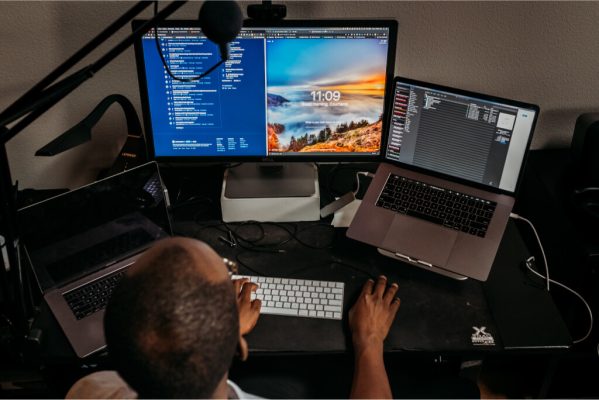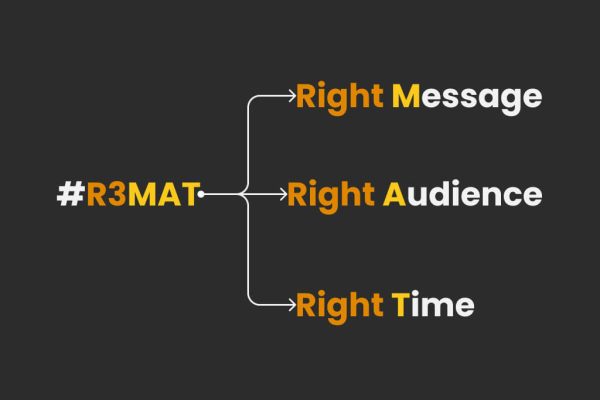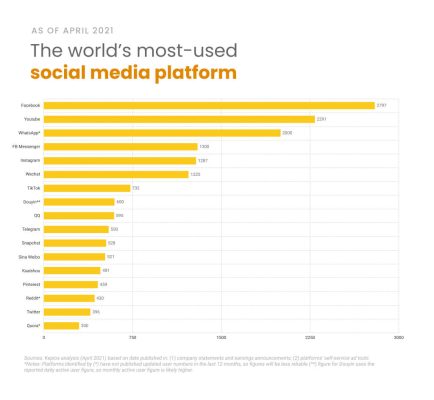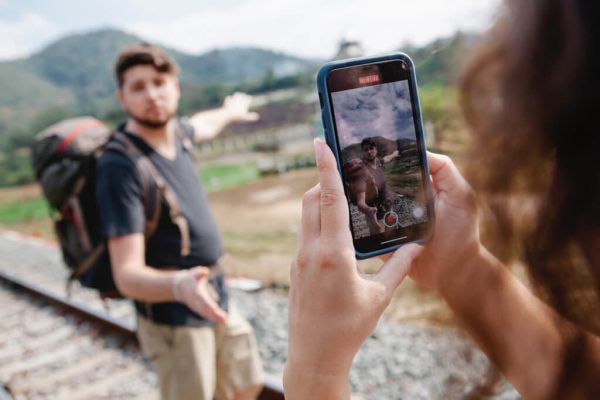https://nasacademy.com/blog/article/5-ways-to-build-your-brand-as-a-content-creator

Our world is made up of brands.
Brands that are driven by content which is far more accessible than ever before. In fact, as a content creator, you’re building your brand with every single post online – every image, story or video is shaping the way your followers will ultimately think of you and your content.
The truth is people turn to social media every day for many reasons – to stay informed, to get answers, to make them laugh or simply, to kill time. For every piece of information they’re looking for, there will always be a content creator somewhere in the virtual universe ready to give them exactly what they want – anytime, any place.
So, if you’ve just recently jumped on the content creation bandwagon, or have been on it for quite some time now, this guide will help you make your brand stand out from the rest.
If you think a brand only refers to a business, then you need to wake up and smell the Starbucks coffee! There’s far more to it than simply a distinct name or logo.
You should think of the word ‘brand’ as the sum of experiences that shapes people’s perception about a product, a service or a person. This extends to both the experiences that can be controlled and the ones you did not see coming at all.
So, as a content creator, you’re positioning yourself as a brand the minute you start thinking of ways to make yourself stand out online. This could involve something as simple as creating a social media aesthetic, or a little more drastic like producing content from the most remote places in the world.

According to research conducted by Google, 70% of teenage YouTube subscribers felt like they can relate more to YouTube creators than traditional celebrities – the result being that 6 in 10 YouTube subscribers would follow advice on what to buy from a creator than a TV or movie personality.
Sharing content online is easy, building a brand is tougher.
While both require consistency, the latter will help you establish a deeper connection with your followers. In other words, once you’ve made a strong impression on people, you’ll no longer be just another content creator or influencer.
Your brand will define the way they’ll think about your content – so it needs to be reflected in every single thing you do on your channel. Remember, this is not a process that can happen overnight, it requires plenty of time, patience and (you guessed it!) consistency.
A huge part of this involves staying true to yourself – but you’ve already heard that before. So, why exactly is this important? Well, because you can’t be everything to everybody. Let that sink in for a minute.
Now, take a moment and think about what makes famous creators like Peter McKinnon and Chris Burkard different from each other? Even though they both produce similar content, you’ll immediately notice that their images have distinct styles – so much so that you’d be able to tell the difference at first glance.
Having hit a million followers within the first 9 months of starting his YouTube channel, Peter McKinnon currently teaches videography and photography trends on both Instagram and YouTube. He is known for his exceptional landscape images using shadows and contrasts to emphasize the whites and blacks – manipulated in a way that creates either a warm or cold atmosphere.
McKinnon’s content strategy relies largely on producing tutorials that deliver value to his subscribers. He has also experimented with other styles of content including vlogs, gadget-related and motivational videos. This ensured that his content was highly shareable and gave him the traction he needed as a creator. McKinnon also followed a strict posting schedule – uploading 180 videos in his first year on YouTube, which meant 3-4 videos every single week.
Chris Burkard, on the other hand, had a different content creation journey. Starting out as a surf photographer, Burkard eventually decided to build a full brand that focused on his core speciality: landscapes. But unlike McKinnon, his images are pulled-back compositions that portray the contrast of humans placed in nature. As such, he does not rely too much on heavy-handed edits and tends to use a lot natural lighting – in an effort to make the images look like how they were perceived in the moment they were taken.
While Burkard’s Instagram showcases his imagery, his YouTube channel remains a platform for displaying his different video projects including collaborations with brands such as Sony. He also diversifies content to earn income particularly from the following sources – commercial photography, editorial photography, prints and books, image licensing, appearance and speaking, and social influencer work.
So, while both McKinnion and Burkard are landscape photographers with a massive following online, they’ve both clearly adopted different styles and approaches to content creation on social media platforms, making them well-respected in their fields. Similarly, no matter what field you’re in, chances are you’ll easily find at least 10 more content creators talking about the same subject and giving the same advice. But what’ll help distinguish your content from theirs – is your personal voice.
Your followers can get the same information anywhere else, but there’s a reason why they choose to trust your advice instead. Maybe it’s because of your fresh take on an old idea or because you sound more confident about your opinions – whatever it is, you have that extra something that’s missing in other creators.

Once you’ve established your voice, you need to learn how to use it as a guide even for determining the type of content you’ll create. This will also largely depend on your brand personality – for instance, do you want people to feel inspired or entertained? You need to develop a connection with every individual without even speaking to them directly.
The only way you can deliver value through your content is when you know who you’re creating content for. This means, you need to identify your target audience and truly understand what it is that they’re looking for online.
Your personal branding process is incomplete without an audience because at the end of the day, they’re the ones who’ll pay your bills. So, you need to take the time to examine their interests and challenges – and then, to produce content that can either get their attention or help solve their problems.
Consider the case of Casey Neistat, one of the most recognizable YouTubers in the world, who did just that. Back in 2003, Neistat recognized a major problem with Apple’s battery replacement program for the iPod – the fact that there wasn’t one.
So, he decided to highlight this issue in a guerilla-style video titled iPod’s Dirty Little Secret which instantly went viral all over the world. Not only did it get Neistat the exposure he wanted as a creator, but it also led Apple to introduce a battery replacement policy – only two weeks after the video was posted.
Even after more than decade, Niestat’s video continues to epitomize the one-to-one relationship shared between creators and followers. That’s because even today, when people look for information about iPod problems online, chances are they’ll end up coming across this video – the one that forced one of the most valued companies in the world to rethink their product policies.
This is the power of content that’s made with intention. It can spark a conversation, introduce new policies and change the world – only if you create it for the right purpose, and the right audience. In other words, learn to apply the #R3MAT methodology in every post that you create – this means showing the right message to the right person at the right time with the right expectations.

Neistat’s strategy is one that you can easily apply to your own content too – ‘personality-driven content’ involves telling your brand’s story through an authentic point of view. Since your audience is likely to have a short attention span, you need to generate engagement based on something they don’t already know.
By creating a compelling brand story, you will be able to arouse the interest of your followers in a way that resonates with them. A case in point is Neistat’s advertisement for Nike FuelBand that featured the creator spending his entire marketing budget on traveling around the world in ten days – while talking about what the brand’s slogan “make it count” meant to him.
The resulting video diary had a powerful story and high relatability factor – gaining 790,000 views in one day – and nine years later, more than 30 million views.
These days it’s simply not enough to be a content creator – you need to be an expert, a filmmaker and a friend all rolled into one. This is why you’ll find that even the most successful creators make a genuine effort to interact with their followers.
Think about it this way – every positive interaction has the potential to turn a casual social media user into a lifetime fan. People don’t want to simply look at your content, they want to feel involved too. Once you’ve opened the lines of communication, you’ll get a chance to truly understand your followers and build a brand persona they’ll like.

When you try to resonate with your core audience, they’ll engage with you more, increase your overall brand visibility and help you gain new followers too. If you’re just starting out, interacting with followers will give you a better idea of how they like to consume content, at what time of day, on which social media platforms, etc.
You can use this information to develop an efficient content promotion plan – one that reflects your brand’s personality and helps entice people to view your channels.
Remember, you cannot have 100% control over how people will think of you and your brand, but you can always try to make a great first impression. With the rise of cancel culture on social media, this could also be a great way to manage your brand reputation and improve your image online.
American YouTuber Logan Paul‘s redemption story proves this. Having received major backlash in 2018 for filming an apparent suicide victim in the Aokigahara forest of Japan, the creator later took to Twitter to post an apology.
Over the course of almost four years, Paul did everything he could to gain back credibility in the eyes of his followers. From taking on new projects such as podcasts and documentaries to even going into the ring as an amateur boxer, Paul remained active on the internet as opposed to disappearing from it like other influencers would.
His efforts eventually paid off – today, Paul along with his brother Jake (another popular creator), each have over 20 million subscribers on YouTube. While the Internet deemed him “canceled”, Paul chose not to hide from his controversies but to use them as an opportunity to learn from his mistakes – even to pass it on as advice to other influencers who might be going through their own online scandals.
It can be tempting to branch out immediately on different platforms especially when you’re new to content creation. But instead of immediately spreading yourself too thin, you need to first figure out where your audience is rather than what platform is currently trending.
Once you’ve found your target market, structure your content in a way that attracts your niche audience. As you begin to develop a solid following on one social media channel, you’ll find the confidence you need to expand your brand to other platforms too.
Huda Kattan, one of the most followed beauty influencers online, adopted a digital strategy that successfully leveraged the power of various social media platforms. Starting out with her own beauty blog in 2010, Kattan later launched her own YouTube channel where she created makeup looks, suggested DIY beauty hacks and reviewed other products in the market.
She went on to do this for three years before founding her brand, Huda Beauty, in 2013 – the brand practically exploded overnight because of her massive online fanbase.
Even today, Kattan continues to maintain a strong online presence by posting regular content on all her channels – which has since expanded to include Instagram and Twitter as well. Since video posts receive higher engagement, her content mix focuses on tutorials, memes, funny videos, etc. Moreover, Kattan strives to give a personal touch to each of her videos, and even teams up with other beauty influencers from time to time, helping promote their products too.
If you still need convincing, consider this recent global social media stats – a typical user visits more than six different channels each month, and spends an average of close to two and a half hours using social media each day – that’s roughly 15 percent of their waking lives.

This is why it’s a good idea to have a cross-platform strategy – it’ll help increase your reach, extend your earning potential and even protect you from unexpected developments such as a channel getting banned in some countries due to security concerns.
But remember, each platform works differently and you’ll need to diversify your content to keep it in line with your target market’s interests on each channel. If you find yourself struggling to do this, hire yourself a small team of freelancers to keep you going.
Content creation never stops. The only way for you to build your brand is to post consistently. Otherwise, people will forget about your channel and move on to another creator.
Successful creators are always looking for ideas or inspiration for content – even when they’re traveling. This is because social media is all about real-time updates and creators need to constantly stay on top of trends.
A good example to consider here is that of travel vlogger Drew Binsky. After moving to South Korea as a teacher, Binsky turned to vlogging as a way to document his daily experiences. In 2015, while traveling to India, he chose to upload his videos on an emerging platform called Snapchat. This meant, sticking to a punishing schedule that involved shooting, editing and uploading a video almost every single day – regardless of flight cancellations, food poisoning or bad internet connections.
Eventually, Binksy moved to other social media platforms such as Facebook, Instagram, YouTube and TikTok – telling stories of both people and places each time he traveled. From the man who speaks 22 languages to the world’s strangest city, he grabbed on to every opportunity he could find to create engaging content. After 9 years and 194 countries, Binksy is considered to be one of the world’s most popular travel vloggers, and is currently working on an upcoming documentary about his travels.
This is why you need to be consistent with your content especially if you’re serious about making it big as a creator in the long run. While you don’t need to post every single minute, you should aim to appeal to your target audience without overwhelming them with content.

You can test out your optimal posting frequency by following a content calendar – this should also allow you to schedule posts in advance. As you get a better idea of what works, update the calendar and plan your content accordingly.
There’s a lot that has changed for content creators over the years. Today, anybody with a smartphone can become a creator and gain a following that is even bigger than the population of some countries.
The creator economy is now run by individuals who can easily get their work published online without the need for long drawn out consultations or approvals. This means that now more than ever, creators are generating significant, diverse and valuable content – helping build brand equity.
Like your content, your brand needs to grow and evolve too or you might find yourself in a position where your channel no longer appeals to your target market. As technological and social changes take place around us, you can expect your followers to have different expectations from your content.
Brand evolution will help prove that you’re on top of industry trends and styles, and gives you a chance to tap into markets and platforms you probably wouldn’t have thought of exploring before.
5 years ago, the world had 5 million social media creators. Today, that number is over 50 million.
Welcome to the Creator Revolution. Now, for the first time ever, you can actually get a job doing what you love.
You can be a social media manager, a digital marketer on TikTok, or a community manager on Discord. Not only are these the world’s newest jobs, they are guaranteed to be in-demand in future. And they are way more fun than your average 9 to 5, and pay even better! But there hasn’t been one single place to learn all these skills. Until now.
This is the Creator Accelerator Program. We designed this program to help you skyrocket your career as a creator. From learning how to grow on social media platforms, to building a network and accessing job opportunities with the world’s top brands – this immersive program will transform your career in just 5 months.
By Admin Nas Academy
By Admin Nas Academy